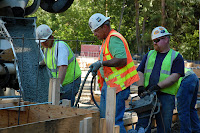 Construction has now been underway for over two months and site work is nearing completion. A photo essay that chronicles construction progress is being produced on the Museum’s WASteam site. In that essay you can see that trees and other vegetation have been removed, the site has been graded, a piling system has been installed, and approximately 1/3 of the plinths have been completed. In a few days, workers will begin to form the stem wall that runs around the perimeter of the building. Meanwhile, the new sewer lines have been installed, and nearly all the new water mains and hydrants are installed, tested and in service.
Construction has now been underway for over two months and site work is nearing completion. A photo essay that chronicles construction progress is being produced on the Museum’s WASteam site. In that essay you can see that trees and other vegetation have been removed, the site has been graded, a piling system has been installed, and approximately 1/3 of the plinths have been completed. In a few days, workers will begin to form the stem wall that runs around the perimeter of the building. Meanwhile, the new sewer lines have been installed, and nearly all the new water mains and hydrants are installed, tested and in service.
There is a great deal of agonizing detail that goes into a museum building and every detail is important. Funders want to know they are getting good value for their investment, city inspectors want proof that the building has been built in accordance with the approved design, representatives of the Federal government want proof that prevailing wages have been paid and that only American steel has been used, and Museum representatives want proof that the needs of the collection and the visiting public are being addressed.
So let’s look at one detail: windows. The design calls for a minimum insulating value. It also calls for UV (ultraviolet) filters in every pane of glass to ensure at least 95% of the sun’s damaging UV rays never enter the building. And the color of the frames must match the design too. Unfortunately ensuring these details are met requires a lot of administration and involves the supplier, the general contractor, the resident engineer, the architect, a Federal representative (because of a Federal grant), and the Museum’s representative. All have to be in agreement before the windows can be ordered.
So is it all worth it? Of course! An indoor exhibit building for coaches, freight cars and locomotives is the most important project in the Museum’s 52 year history and is the single biggest investment in sustainability that the organization has ever made. Placing artifacts inside the Train Shed will almost completely halt deterioration caused by rain, wind and sun. So our children’s children should be able to visit the Northwest Railway Museum 30 years from now where they can see and understand the role railroads played in the settlement and development of the Northwest.

